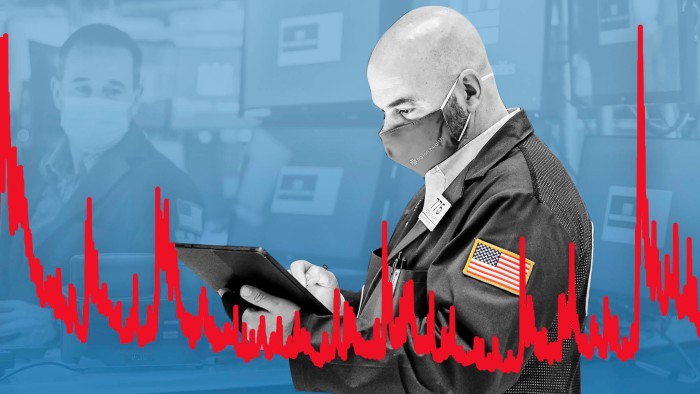US post-pandemic boom overcomes market fears

Roula Khalaf, Editor of the FT, selects her favourite stories in this weekly newsletter.
Measures of volatility in financial markets have hit the lowest levels since the pandemic rocked stock and bond prices last year, as investors bet on tranquility and ride a wave of optimism about the US economic recovery.
The closely followed Vix index, which measures implied volatility on S&P 500 index options, earlier this month dropped below its long-term average of 20 and remained there even during a period of losses for equities last week. On Monday, the Vix ended the day at 17.64, roughly a fifth of the level seen at the most intense point of last year’s shake-out in stocks.
Calmer trading by retail investors, who had roiled the market with idiosyncratic bets on unloved stocks during the pandemic, has helped to settle the volatility, though some tussles between sectors persist beneath the surface.
The stability is one indication that investors believe the risk of lasting damage to markets from the pandemic has faded, particularly in light of strong economic and earnings data in the US.
“It just feels like when you look out at the economic picture for the next three to four quarters, it’s really hard to construct a bear story in any way,” said Grant Bowers, a portfolio manager at Franklin Templeton. “People call [the Vix] the fear gauge. And there’s not a lot of fear out there.”

One of the key reasons for stability in big stocks indices, and for lower expectations of volatility, is the rethink among investors over the prospects for various corporate sectors. Since the discovery of vaccines to tackle coronavirus, lockdown-era winners such as tech companies have surrendered some market leadership to beaten-up sectors such as banking and travel.
That leaves some market shifts bubbling beneath the surface while broader indices appear steady.
“Even though tech stocks are quite volatile and financial stocks are quite volatile, the moves cancel each other out,” said Glenn Koh, head of equities trading at Bank of America.
But other factors are at play. In particular, increasingly optimistic fund managers have become more willing to navigate markets without a safety net. As their confidence grows, some funds have been selling the insurance contracts they had sought out as a protection against market turmoil over the past year, according to traders and money managers.
The ramp-up in sales of these derivatives in recent weeks also bolsters hedge funds and asset managers’ returns, as they collect large premiums when they agree to the contracts.
“You have seen the dam crack,” said Brian Bost, co-head of equity derivatives in the Americas at Barclays. “Supply has finally outstripped demand and the realised volatility environment has remained subdued for long enough” that the premium investors demand to sell volatility “had to be reset lower”.
The resilience of stock markets in the face of a shake-up in government bonds at the start of this year gave investors a green light to sell protection against market shocks.
This tactic backfired when the pandemic hit markets last year, pushing derivatives funds including Malachite Capital Management and two funds managed by Allianz to either liquidate or return clients’ money. Now, it is once again in favour.
“In 2020 if you sold volatility, you lost money,” said one senior equities trader. “But as the market has stabilised, we’ve seen more sellers.”

Instead of relying on equity derivatives, fund managers were returning to relatively cheap 10- and 30-year Treasuries to provide ballast to their portfolios, said Rish Bhandari, a senior portfolio manager at hedge fund Capstone.
One of the stranger trading patterns of 2021 has also dissipated, as retail traders who had flooded US equity and derivatives markets during the pandemic back away from markets.
Equity trading volumes in the US have averaged 11bn shares a day over the past 30 days, down from a high of 15.8bn in March. Small-sized option trades — a proxy for overall retail trading activity — have dropped 40 per cent from their peak at the end of January. This suggests that small investors’ fad for buying call options — bets on rising prices — is dying down.
“A contributing factor here is the fact that retail call buying demand has dropped like a stone,” said Amy Wu Silverman, head of derivatives strategy at RBC Capital Markets. Call option trading on hyper-popular so-called meme stocks such as GameStop had dropped “dramatically” from the peaks of August 2020 and January 2021, she said.
Investors are not necessarily betting on a docile trading environment for the rest of the year. Vix futures contracts that expire between June and December are changing hands between 22 and 25, well above the spot price of 17.64.
Some funds selling options are doing so only through short-dated contracts that expire in a few weeks or a month, in an attempt to limit their risks. Their bet is that any broad market shock would take longer than a few weeks to materialise, safeguarding the sellers.
Traders are also pointing to the rise in the VVIX index in April, which measures the expected volatility of the Vix index. VVIX has remained well above its pre-pandemic level, suggesting that investors believe volatility might soon pick up again, according to Chris Murphy, co-head of derivative strategy at market maker Susquehanna.
Comments